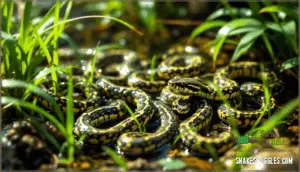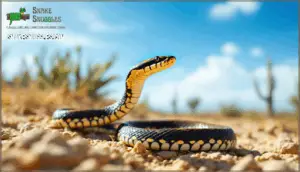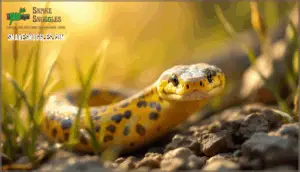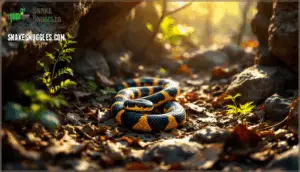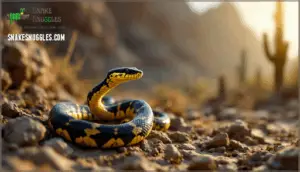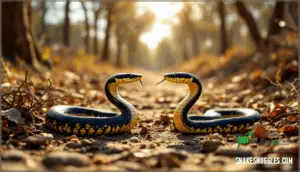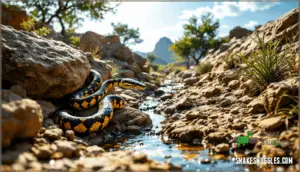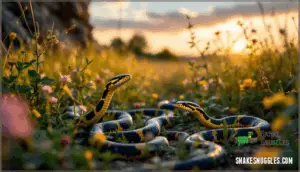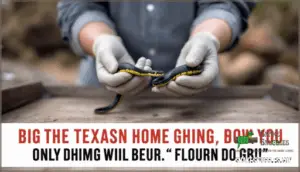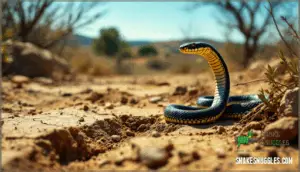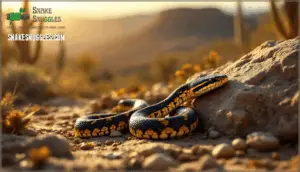This site is supported by our readers. We may earn a commission, at no cost to you, if you purchase through links.

Across Texas, at least five distinct species sport these warning colors, but only one poses genuine danger. The difference between a beneficial garden resident and a potentially lethal encounter often comes down to subtle details: the order of color bands, head shape, and behavioral cues that reveal each snake’s identity. Knowing how to read these field marks transforms fear into informed confidence when you cross paths with these striking reptiles.
Table Of Contents
- Key Takeaways
- Types of Black and Yellow Snakes
- Characteristics of Black and Yellow Snakes
- Habitat and Distribution in Texas
- Venomous Vs Non-Venomous Black and Yellow Snakes
- Behavior and Diet of Black and Yellow Snakes
- Safety Precautions Around Black and Yellow Snakes
- Common Misconceptions About Black and Yellow Snakes
- Handling and Capturing Black and Yellow Snakes
- Black and Yellow Snake Bites and Treatment
- Interesting Facts About Black and Yellow Snakes
- Frequently Asked Questions (FAQs)
- What are the black snakes with yellow stripes in Texas?
- Is a Texas garter snake poisonous?
- Are black and yellow king snakes poisonous?
- Is a black snake with a yellow stripe down its back poisonous?
- What are the predators of black and yellow snakes?
- How do black and yellow snakes reproduce?
- What is the lifespan of black and yellow snakes?
- Do black and yellow snakes shed their skin often?
- Are black and yellow snakes active during a specific season?
- How long do black and yellow snakes live?
- Conclusion
Key Takeaways
- Only one of five black and yellow snake species in Texas is venomous—the coral snake, identifiable by red bands touching yellow bands and a rounded black snout, but it accounts for less than 1% of venomous bites in the state.
- Harmless species like garter snakes, kingsnakes, and rat snakes actively control rodent and pest populations, making them valuable allies in Texas ecosystems rather than threats to avoid.
- Simple field identification saves lives: check for triangular heads and heat-sensing pits in pit vipers, or the "red on yellow, kill a fellow" banding pattern in coral snakes, while most other black and yellow snakes display rounded heads and flee when approached.
- If bitten by a venomous snake, skip tourniquets and ice—instead, stay still to slow venom spread, remove jewelry near the wound, and call 911 immediately for antivenom treatment, which works best within six hours.
Types of Black and Yellow Snakes
When you’re out in Texas, you’ll come across several black and yellow snakes, each with its own look and personality. Some are harmless helpers around your property, while others demand serious respect.
Let’s break down the four main types you’re likely to spot.
Garter Snakes
You’ll spot garter snakes across Texas in gardens, wetlands, and grassy areas near water. These nonvenomous beauties sport striking black and yellow stripes running head to tail—perfect camouflage in dappled vegetation. Checkered garter snakes (Thamnophis marcianus) show yellow crossbars against dark backgrounds.
Generally stretching 18–24 inches, they feast on earthworms, amphibians, and small fish, keeping pest populations in check. Their slender bodies manage moist environments beautifully, making them adaptable neighbors worth protecting through habitat conservation.
Understanding the role of snakes in ecological balance is vital for their preservation.
King Snakes
Kingsnakes roam Texas as nonvenomous constrictors wearing bold black and yellow patterns that sometimes mimic venomous coral snakes—nature’s clever disguise. Desert kingsnakes (Lampropeltis splendidis) showcase striking yellow flecking, while speckled kingsnakes (L. holbrooki) sport spotted scales across 3–4 foot bodies. You’ll find these adaptable predators in grasslands, woodlands, and desert habitats, where their impressive diet includes rodents and even rattlesnakes. Kingsnakes often exhibit actions similar to those of venomous snake species to deter predators.
- Snake mimicry protects kingsnakes by resembling dangerous species without the venom
- King Snake Conduct includes tail-shaking and musk release when threatened
- Snake Conservation benefits from kingsnakes controlling rodent populations naturally
- Texas kingsnakes thrive in diverse environments from prairies to river bottoms
Rat Snakes
Texas rat snakes (Pantherophis obsoletus lindheimeri) stretch 4–5 feet long with yellow or tan bodies marked by irregular brown or olive-green blotches—southern specimens showing brighter yellows. You’ll recognize their distinctive solid grey heads across Rat Snake Habitats, from woodlands to barnyards throughout Texas, where they’re champions of Snake Conservation by naturally controlling rodents. These nonvenomous constrictors display fascinating Rat Conduct as stealthy hunters.
- Snake Patterns: Color variations include rare albino and leucistic forms
- Range: Found across Texas into Louisiana, Arkansas, and Oklahoma
- Benefits: Among the most valuable snake species in Texas for pest control
Coral Snakes
Unlike rat snakes that patrol barnyards, the Texas coral snake (Micrurus tener) prefers undisturbed habitats like leaf litter and rocky crevices.
You’ll identify this venomous species by its black, yellow, and red bands that circle the entire body—remember "red on yellow, kill a fellow" for snake identification.
Identify venomous coral snakes by their red-yellow-black bands where red touches yellow—remember red on yellow, kill a fellow
Most measure around 24 inches, though they can reach 48 inches. Coral snake venom contains potent neurotoxins causing snake bite symptoms like paralysis, making immediate medical attention critical despite their shy behavior and reluctance to strike.
Characteristics of Black and Yellow Snakes
When you spot a black and yellow snake in Texas, knowing what sets each species apart can mean the difference between a safe encounter and a dangerous one.
These snakes vary in their patterns, body build, and overall size—details that help you make a quick, accurate ID in the field. Let’s break down the key characteristics you’ll want to watch for.
Color Patterns
When you’re face-to-face with a black and yellow snake in Texas, those bold stripes and bands aren’t just for show—they’re nature’s way of sending a message, whether it’s "back off" or "I’m harmless, I promise." Here’s what to watch for in color patterns:
- Striped variations run lengthwise on garter snakes
- Banding styles circle coral snakes with red-yellow-black rings
- Color morphs vary regionally across Texas populations
- Hue shifts from bright yellow to cream depending on age
- Pattern changes help distinguish venomous vs nonvenomous snakes
These visual cues are your field guide to snake identification.
Body Shapes
A snake’s silhouette says more about its lifestyle than most people realize—thick-bodied pit vipers built for ambush hunting look nothing like the lean, agile racers that chase down prey in open terrain.
In Texas, body proportions matter for snake identification. A coral snake’s slender frame differs dramatically from a rattlesnake’s hefty build. Head shapes vary too—triangular in venomous species, rounded in harmless ones. Scale patterns and tail lengths complete the picture, helping you distinguish one black and yellow snake species from another.
Size Variations
From pencil-thin coral snakes to thick-bodied rattlers stretching over four feet, black and yellow snakes in Texas span a surprising range of lengths and builds. The Texas Coral Snake stays compact at 20-30 inches, while garter snakes can reach three feet or more. Growth patterns differ too—rattlesnakes bulk up as they age, developing heavier body proportions for ambush hunting. Length comparison helps with snake identification in the field, especially when distinguishing venomous snakes from harmless lookalikes.
Size distribution matters when you’re trying to ID that black and yellow snake crossing your path—juvenile rattlers look nothing like their hefty parents.
- Coral snakes: Slender, rarely exceeding two feet
- King snakes: Mid-sized, averaging 3-4 feet with muscular builds
- Rat snakes: Longest of the bunch, sometimes hitting six feet
- Garter snakes: Variable, usually 18-36 inches depending on subspecies
Habitat and Distribution in Texas
Where you find black and yellow snakes in Texas depends entirely on which part of the state you’re exploring. The Lone Star State’s varied terrain—from humid eastern forests to arid western deserts—creates distinct homes for different species.
Let’s look at where these snakes set up shop across Texas.
Eastern Texas Habitats
You’ll find Eastern Texas snake habitats draped in humidity and green shadows. Pine forests, swamp ecosystems, river corridors, and coastal plains create perfect refuges for black and yellow snake species like the Texas rat snake and venomous coral snakes.
Wetland areas near Houston and San Antonio support diverse populations. When you’re identifying snakes in these moist, sheltered environments, watch for movement under logs or near water—that’s where venomous snakes and their harmless cousins both hunt and hide.
Western Texas Habitats
Out west, you’ll encounter black and yellow snakes across desert landscapes, rocky outcrops, and arid ecosystems that stretch from canyon habitats to semi-desert regions. Texas coral snakes and Western diamondback rattlesnakes navigate these harsh terrains, sheltering in rock crevices and pine-oak woodlands at elevations up to 12,000 feet.
When you’re exploring these venomous snake habitats, respect their space—they’ve mastered survival where water’s scarce and temperatures swing wildly.
Preferred Environments
You’ll discover that habitat diversity shapes where these reptiles thrive—from the grasslands and woodlands of Central Texas to underground retreats in urban parkland. Understanding these environmental adaptations and Texas’s snake microclimates helps you predict encounters and appreciate their ecological niche:
- Shelter sites: Fallen logs, rock crevices, abandoned buildings, and animal burrows
- Activity windows: Spring through early summer, especially after rainfall above 78°F
- Geographic distribution: All 254 counties, from southern forests to western desert margins
Venomous Vs Non-Venomous Black and Yellow Snakes
When you’re face-to-face with a black and yellow snake in Texas, knowing whether it’s dangerous or harmless can make all the difference. The good news is that most species you’ll encounter won’t pose a threat, but a few venomous ones demand your respect and caution.
Let’s break down the key differences so you can identify what you’re looking at with confidence.
Identifying Venomous Snakes
You’ll spot venomous snakes in Texas by checking three key features. First, examine Snake Head Shapes—pit vipers like rattlesnakes have triangular heads, while the Texas Coral Snake shows a rounded profile with a black snout. Second, study Color Pattern Analysis carefully: coral snakes display red-yellow-black bands where red touches yellow (remember "red to yellow kills a fellow"). Third, watch for warning signs—rattlesnakes shake their tails, signaling danger. These Venom Detection Methods help you identify venomous snakes in Texas and distinguish them from harmless black and yellow snake species.
| Feature | Venomous (Coral Snake) | Venomous (Pit Vipers) |
|---|---|---|
| Head Shape | Rounded, black snout | Triangular, heat-sensing pits |
| Pupil Type | Round | Elliptical (cat-like) |
| Banding Pattern | Red touches yellow bands | Dark geometric patterns, rattle |
| Actions | Reclusive, rarely seen | Defensive rattling or gaping |
| Snake Venom Types | Neurotoxins (nerve damage) | Hemotoxins (tissue damage) |
Venomous Bite Symptoms vary—coral snake bites cause paralysis and breathing trouble, while pit viper bites bring immediate pain and swelling. Understanding snake identification keeps you safe during Texas adventures.
Characteristics of Non-Venomous Snakes
Once you’ve ruled out the venomous suspects, you’re left with a friendly lineup of non-venomous snakes that share some tell-tale features—rounded heads, smooth movements, and a habit of fleeing rather than fighting. Texas garter snakes and kingsnakes show these non-venomous traits clearly. Their snake body types appear slender with uniform thickness, while snake scale patterns stay consistent without dramatic color breaks. Watch for harmless snake behaviors like rapid retreat and snake camouflage methods that help them blend into vegetation rather than warn predators away.
| Feature | Non-Venomous Characteristics |
|---|---|
| Head Shape | Rounded, narrow neck absent |
| Defense Strategy | Flee quickly, may musk or play dead |
| Movement Pattern | Smooth, fluid locomotion without aggression |
Behavior and Diet of Black and Yellow Snakes
Understanding how black and yellow snakes behave and what they eat can help you feel more confident when you spot one in Texas.
These snakes have distinct hunting styles and dietary needs that shape where and when you’ll encounter them. Let’s look at their hunting habits, prey preferences, and social behaviors.
Hunting Habits
Watch a garter snake hunting and you’ll see patience rewarded—these striped predators rely on stealth, timing, and lightning-fast strikes to catch their next meal. Black and yellow snakes in Texas use varied hunting strategies depending on species. Kingsnakes actively search cover, while rattlesnakes employ ambush tactics with heat-sensing precision. Understanding snake conduct helps with proper identification and predator avoidance during encounters.
Five hunting techniques you’ll witness:
- Sit-and-wait ambush – Venomous species conserve energy by remaining motionless
- Active foraging – Non-venomous hunters patrol territories systematically
- Chemical tracking – Tongue-flicking detects prey scent trails
- Constriction holds – Kingsnakes squeeze without venom
- Strike-and-release – Rattlesnakes inject venom, then track dying prey
Prey Preferences
After the strike comes the meal—and what these Texas snakes choose to eat tells you a lot about who they’re and where they hunt. Garter snakes favor amphibians and earthworms in moist areas, while kingsnakes target other reptiles—including venomous species.
Rattlesnakes specialize in warm-blooded prey like rodents and rabbits, using heat-sensing pits to track mammals. Rat snakes climb trees for bird eggs and nestlings.
Each species’ prey selection reflects its hunting tactics and role in local food chains, maintaining predator-prey balance across Texas ecosystems.
Social Interactions
Most snakes aren’t social butterflies—they’re loners by nature, coming together only when the situation demands it. In Texas, black and yellow snake conduct centers on survival, not socializing. Here’s what snake communication and group conduct look like:
- Mating season gatherings: Males compete through combat dances, intertwining bodies to establish dominance.
- Hibernation clusters: Garter snakes share winter dens, benefiting from collective warmth—a rare social learning moment.
- Territorial warnings: Rattlesnakes use tail rattles for human interaction and coexistence strategies, preventing conflict.
- Feeding independence: No cooperative hunting; each snake hunts solo, avoiding competition with wildlife.
Understanding snake ecology helps you respect their space and conduct patterns.
Safety Precautions Around Black and Yellow Snakes
You don’t have to live in fear of every snake you see, but smart precautions make all the difference when you’re in black and yellow snake territory. Knowing how to avoid surprise encounters, what to wear, and how to respond if bitten can keep you safe without limiting your outdoor adventures.
Let’s walk through three essential safety strategies that’ll give you confidence in snake country.
Avoiding Snake Encounters
You don’t have to stumble across a snake to end up face-to-face with one—knowing where they like to hang out puts you a step ahead. In Texas, snake safety starts with understanding encounter prevention. Watch for warning signs like rustling in leaf litter or coiled shapes near rock piles—these defensive measures can save you from a close call with venomous species.
Stick to cleared trails during hikes, since tall grass and brush hide snakes beautifully. Keep your yard tidy by removing debris piles and sealing gaps under sheds where snakes seek shelter. Snake avoidance means respecting their territory: don’t reach into crevices or flip logs without checking first.
Outdoor safety and proper snake identification go hand-in-hand, turning caution into confidence when you’re exploring snake country.
Protective Gear
Think of protective gear as your insurance policy when you’re out in snake territory—the right equipment turns a potential trip to the emergency room into just another day outdoors. Snake gaiters and tall boots made from thick leather or puncture-resistant materials shield your lower legs, where most strikes happen in Texas.
- Snake-proof boots: Look for boot materials like full-grain leather or Kevlar that fangs can’t penetrate
- Snake gaiters: Legging types that wrap around your calves provide extra defense in tall grass
- Sturdy gloves: Glove options with reinforced palms protect your hands when moving logs or rocks
Eye protection and long sleeves complete your outdoor safety kit, giving you confidence during snake identification without risking a venomous encounter.
First Aid for Snake Bites
When a black and yellow snake’s fangs connect with your skin, every second counts—but your first instinct might actually do more harm than good. Skip tourniquets and suction kits—they worsen snake bite symptoms.
Instead, keep still to slow venom spread, remove jewelry near the wound, and call 911 immediately. Proper wound cleaning happens at the hospital, where emergency response teams deliver antivenom treatment.
Your job? Stay calm and get medical help fast.
Common Misconceptions About Black and Yellow Snakes
You’ve probably heard some wild stories about black and yellow snakes—tales that make them sound more dangerous or mysterious than they really are. The truth is, many common beliefs about these reptiles are based on folklore rather than field observations.
Let’s clear up the confusion by separating the myths from what actually happens in Texas habitats.
Debunking Myths and Legends
Coachwhips chasing people down dusty trails, rat snakes hypnotizing pets, hognose snakes spitting deadly venom—Texas folklore paints a dramatic picture that makes Hollywood look tame. But let’s set the record straight on these colorful tales about yellow and black snakes and their cousins:
- Snake chasing: Coachwhip legend aside, these nonvenomous snakes flee from you, not toward you
- Milk myth: No snake steals milk from cows—physically impossible
- Swallowing tails: Hoop snakes rolling downhill? Pure fiction
- Rattlesnake tales: They won’t jump six feet or track you for revenge
- Hypnotic powers: Snake identification trumps superstition—no species mesmerizes prey
Texas snake lore makes great campfire stories, but understanding real conduct keeps everyone safer.
Separating Fact From Fiction
The truth about Texas snakes gets buried under decades of tall tales, but a few simple facts can end the guesswork and keep you confident in snake country. Folklore origins create misidentification risks—yellow and black snakes aren’t all Texas Coral Snakes.
Media influence amplifies snake myths, but debunking legends through proper snake identification reveals most species are nonvenomous. Recognizing venomous snakes requires studying head shape and banding patterns, not trusting campfire stories.
Handling and Capturing Black and Yellow Snakes
Let’s be clear: you shouldn’t touch or capture any snake unless you absolutely need to. If you come across a black and yellow snake in Texas and aren’t sure what it is, your best bet is to observe from a safe distance and snap a photo for later identification.
Here’s what you need to know if touching becomes necessary.
Safe Handling Techniques
Working with a wild snake isn’t something you want to wing—one wrong move and you could end up on the wrong end of a defensive strike. Your best bet for venomous snake control in Texas? Use a snake hook or snake tongs to keep distance between you and the business end.
Gloves and boots add another layer of protection. Support the snake’s body weight, move deliberately, and relocate it to safe habitat away from foot traffic.
Capturing Snakes for Identification
If you’re curious enough to catch one for a closer look, keep in mind that even harmless species deserve respect and a gentle touch. Snake capture tools like hooks or tongs keep management safety risks low while minimizing snake stress—critical when you’re dealing with identification challenges. In Texas, legal considerations matter, especially with venomous snakes. Even a King Snake mimicking danger deserves your caution.
- Use snake hooks or tongs to maintain safe distance
- Photograph color patterns for accurate black and yellow snake identification
- Keep captures brief to reduce stress on the animal
- Check Texas regulations before managing any venomous snakes
- Release captured snakes in their original location promptly
Black and Yellow Snake Bites and Treatment
If you’re bitten by a black and yellow snake in Texas, knowing whether it’s venomous can make all the difference. Quick identification and proper first aid aren’t just smart—they could save your life.
Here’s what you need to know about recognizing dangerous bites and getting the right treatment fast.
Identifying Venomous Bites
Knowing what happens after fangs meet flesh might be the difference between staying calm and making things worse. Venomous bite symptoms develop fast—watch for two distinct puncture marks, intense pain radiating outward, and rapid swelling around the wound. You’ll likely notice discoloration or bruising spreading from the bite site.
Nausea, weakness, and difficulty breathing signal serious venom exposure requiring immediate medical assistance and antivenom options.
First Aid and Medical Treatment
Once symptoms appear, emergency response becomes your priority. Stay calm—panic speeds up circulation and spreads venom faster through your body. Here’s what medical protocols demand:
- Call 911 immediately and arrange transport; don’t drive yourself as dizziness can develop quickly
- Wash the bite area with soap and water, then cover with a clean, dry dressing to prevent infection
- Remove jewelry and tight clothing before swelling starts restricting blood flow
- Keep the bitten limb still and positioned slightly below heart level to slow venom spread
- Skip tourniquets, ice, or pain meds like ibuprofen—these worsen tissue damage and complicate treatment
Antivenom administration works best within six hours but can help up to 24 hours post-bite. Texas hospitals usually keep you 1–3 days for monitoring. Treatment outcomes are excellent when you reach medical care fast—recent data shows zero fatalities among properly treated snake bite cases.
Interesting Facts About Black and Yellow Snakes
Black and yellow snakes in Texas have some surprising traits that go beyond simple identification. These species have evolved clever ways to survive in challenging environments, from mimicking dangerous neighbors to thriving in extreme heat.
Let’s look at what makes these snakes truly extraordinary.
Unique Characteristics
Ever notice how nature sometimes hands certain creatures a "look but don’t touch" warning label stamped right on their skin? Black and yellow snakes wear their caution colors boldly. These striking snake patterns serve as nature’s billboard—advertising danger or, cleverly, just pretending to. The Texas Coral Snake’s vivid bands warn of real venom, while kingsnakes mimic that same look without the bite.
Understanding these differences in body shapes and venomous snake identification keeps you safe while appreciating Texas’s reptilian diversity.
| Feature | Coral Snake | Harmless Mimics |
|---|---|---|
| Color Variations | Red touches yellow bands | Red touches black bands |
| Head Forms | Rounded, black snout | Variable, often triangular |
| Scale Textures | Smooth, glossy finish | Keeled or smooth patterns |
Adaptations and Survival Strategies
Survival in Texas isn’t just about toughing out the heat—these snakes have evolved some seriously clever tricks to stay alive, from color-shifting camouflage that fools predators to venom that doubles as a dinner bell.
Their survival tactics include:
- Camouflage techniques that let rattlesnakes vanish against rocky terrain
- Thermal regulation through burrowing during scorching afternoons
- Predator avoidance via coral snake warning colors
- Environmental adaptation allowing garter snakes to thrive statewide
Frequently Asked Questions (FAQs)
What are the black snakes with yellow stripes in Texas?
Spotting a black snake with yellow stripes darting through Texas brush, you’re likely watching a garter snake, king snake, or possibly a rat snake—all non-venomous species that wear nature’s warning colors without packing venom.
These striped serpents help control rodent populations across Texas ecosystems, making them valuable allies in wild encounters, unlike the dangerously venomous coral snake with its distinctive banded pattern requiring careful snake identification.
Is a Texas garter snake poisonous?
Good news—Texas garter snakes aren’t venomous. They produce mild saliva toxins that rarely affect humans.
You might get a defensive bite if you grab one, but it’s harmless. Just let these striped escape artists be, and you’ll both stay happy.
Are black and yellow king snakes poisonous?
No, black and yellow king snakes aren’t venomous. These non-venomous species are actually beneficial—they hunt rodents and even eat venomous snakes like the Texas Coral Snake.
King snake demeanor is defensive, not aggressive, making them safe around humans if you follow basic snake safety tips.
Is a black snake with a yellow stripe down its back poisonous?
Not usually—most black snakes sporting a yellow stripe down their back are harmless garter snakes. These non-venomous helpers control rodent populations in your yard.
However, snake identification requires caution: always check head shape and banding patterns, since Texas coral snake identification demands attention to "red on yellow, kill a fellow" warnings for venomous snakes in Texas.
What are the predators of black and yellow snakes?
Hawks, foxes, raccoons, and bobcats regularly hunt black and yellow snakes across Texas. Even venomous species like the Texas coral snake aren’t safe from these persistent predators.
Though larger snake species face fewer threats once they reach adult size.
How do black and yellow snakes reproduce?
Most people assume snake reproduction is always the same, but here’s the reality: mating habits vary by species. In Texas, black and yellow snakes engage in courtship rituals during breeding seasons, with males competing for females.
After successful mating, females lay eggs in hidden spots—under logs or in burrows. These clutches incubate for weeks before hatchlings emerge, fully independent and ready to hunt.
What is the lifespan of black and yellow snakes?
Most black and yellow snakes in Texas live 10-20 years in the wild. Species lifespan varies—Texas coral snakes average 7 years, while rat snakes can reach 15-20 years.
Habitat impact and predation pressure affect survival rates markedly across different snake species.
Do black and yellow snakes shed their skin often?
Unlike your favorite jacket that lasts for years, snake skin regeneration happens multiple times annually. Black and yellow snakes shed their skin every 4-8 weeks during active growth periods, with the ecdysis process slowing as they mature—it’s nature’s way of accommodating snake growth patterns.
Are black and yellow snakes active during a specific season?
Most black and yellow snakes in Texas show peak seasonal activity during spring and fall when temperatures hit their ideal range—roughly 70-85°F. Summer heat drives them to hunt at dawn or dusk, while winter sends them into brumation underground.
How long do black and yellow snakes live?
Lifespan varies widely among species—your black and yellow snakes in Texas might live anywhere from 5 to 20 years depending on the species.
Garter snakes usually reach 5-10 years, while kingsnakes and rat snakes can hit 15-20 years in protected habitats where environmental factors favor longevity.
Conclusion
Here’s a jaw-dropper: coral snakes account for less than one percent of venomous bites in Texas, yet they trigger the most fear. When you encounter a black and yellow snake, Texas residents often worry about, remember that four out of five species you’ll meet are allies, not adversaries.
Master the color sequence, watch for behavioral tells, and you’ll move through your yard with knowledge instead of anxiety—turning every sighting into a chance to appreciate these misunderstood reptiles rather than panic.

